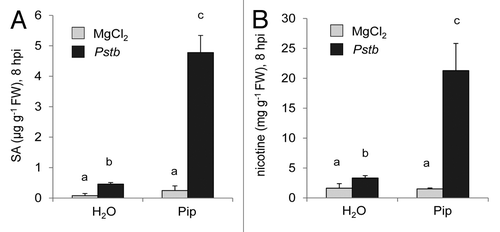Figures & data
Figure 1. Changes in the levels of free amino acids and amines in N. tabacum cv Xanthi leaves upon inoculation with compatible P. syringae pv tabaci (Pstb) 2 d post inoculation (dpi). Mean values of 3 to 5 replicate samples are given in µg g−1 fresh weight (FW) ± SD. Mock-treatments were performed by infiltration of leaves with a 10 mM MgCl2 solution. Asterisks denote statistically significant differences between Pstb- and MgCl2-samples (2-tailed t-test; ***: p < 0.001; **: p < 0.01; *: p < 0.05). Ratios of the values of the Pstb (P)- and the MgCl2 (M)-samples (P/M) are also given.
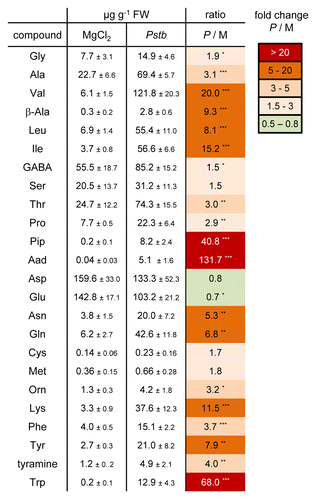
Figure 2. Time course of (A) pipecolic acid (Pip) and (B) α-aminoadipic acid (Aad) accumulation in tobacco leaves inoculated with compatible Pstb at indicated times after inoculation. Dark squares: Pstb-inoculated leaves; light diamonds: mock-treated leaves. Values represent the mean ± SD of 3 replicate samples. Asterisks denote statistically significant differences between Pstb- and mock-samples (***: p < 0.001; **: p < 0.01; 2-tailed t-test).
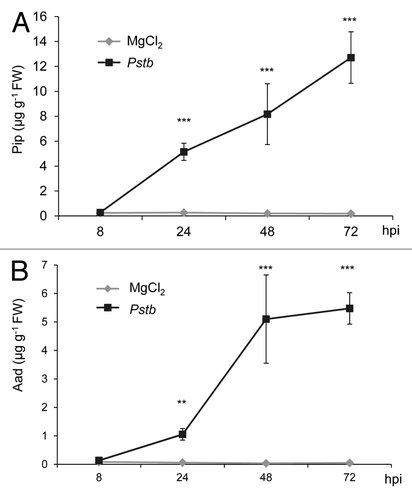
Figure 3. Time course of (A) salicylic acid (SA) accumulation and (B) nicotine production in tobacco leaves inoculated with compatible Pstb at indicated times after inoculation. Light diamonds: mock-treated leaves; dark squares: Pstb-inoculated leaves. Values represent the mean ± SD of 3 replicate samples. Asterisks denote statistically significant differences between Pstb- and mock-samples (***: p < 0.001; **: p < 0.01; *: p < 0.05; 2-tailed t-test).
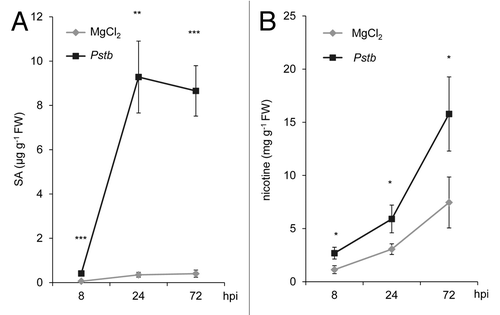
Figure 4. Exogenous pipecolic acid supplied to tobacco plants via the roots is transported to leaves and leads to a slight rise of leaf Aad levels. Leaf contents of (A) Pip and (B) Aad in leaves of tobacco plants 1 d after supplying 10 µmol Pip (10 ml of a 1 mM solution) or 10 ml of H2O via the roots. Light bars: H2O-treated plants; dark bars: Pip-treated plants. Values represent the mean ± SD of 3 replicate samples. Asterisks denote statistically significant differences between samples (***: p < 0.001; 2-tailed t-test).
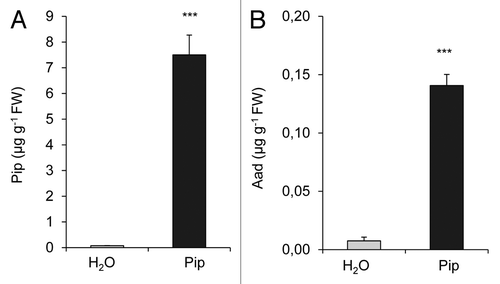
Figure 5. Exogenous Pip enhances disease resistance of tobacco plants to compatible Pstb and non-adapted, HR-inducing Psm. Plant pots were supplied with 10 ml of H2O or 10 ml of 1 mM (≡ 10 µmol) Pip 1 d prior to bacterial inoculation. (A) Bacterial numbers of Pstb (applied in titers of OD 0.001) in leaves at 0 dpi and 5 dpi. The y-axis is depicted in a logarithmic scale. Bars represent the mean ± SD of at least 7 replicate samples. Asterisks denote statistically significant differences between leaf samples of control- and Pip-treated plants (***: p < 0.001; 2-tailed t-test). (B) Representative disease symptoms of Pstb-infected tobacco leaves from H2O and Pip pre-treated plants. (C) Bacterial numbers of Psm (applied in titers of OD 0.005) in leaves at 0 dpi and 5 dpi.
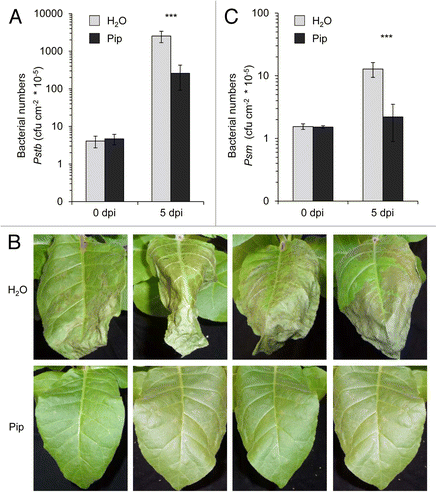
Figure 6. Exogenous Pip primes tobacco plants for effective SA and nicotine production upon Pstb inoculation. H2O or 10 µmol Pip were applied to plants through the soil. Leaves were infiltrated 1 d later with Pstb (dark bars) or MgCl2 (light bars), and leaf metabolite levels were scored 8 h later. (A) SA contents in leaves. (B) Leaf nicotine levels. Bars represent the mean ± SD of 3 replicate samples. Different letters above the bars denote statistically significant differences between pairwise compared samples (p < 0.05, 2-tailed t-test).
